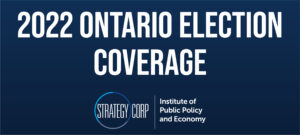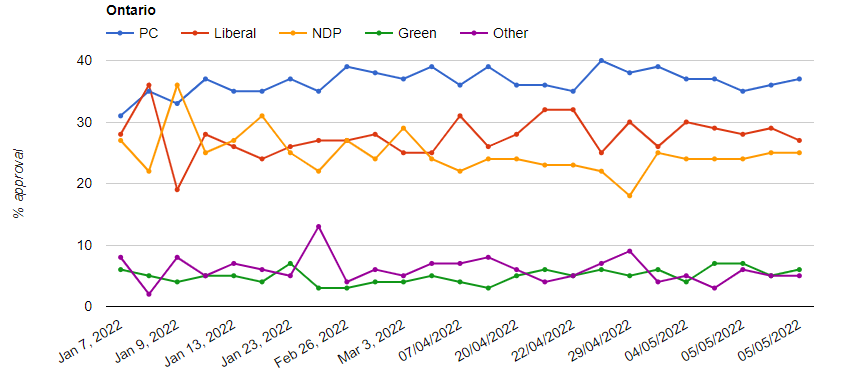State of Play – StrategyCorp’s Weekly Election Update

With the start of Ontario’s 43rd General Election, StrategyCorp is providing weekly election updates. Each week we’ll provide our analysis on the major challenges and opportunities the main parties face on the election trail. This week we focus on the issues core to each party’s campaign, how they differentiate the parties from one another, and what each leader’s path to becoming Premier looks like.
Paths to Victory
Progressive Conservatives
The 2022 version of Doug Ford sounds very different than the Doug Ford who first ran to be Premier in 2018. Like every other political party, Ford has adapted to the impacts of COVID-19. He is now the “guy who says ‘yes’” to all sorts of programs and initiatives, and most importantly, deep provincial spending that he likely would have said no to in 2018. (Highlighting this, the Ford campaign has nicknamed their campaign bus the Yes Express.)
For the 2022 campaign, Ford and the Ontario PCs are running on the slogan of “Get It Done.” Last week’s budget focused on building transit, highways, and infrastructure, investing in priority industries like electric vehicles and critical minerals, and making life more affordable.
The PCs believe this gives them a winning plan to build on the billions of dollars they announced over the past six months. They also believe this differentiates them from their rivals – the PCs have accused both the NDP and Liberals of refusing to support projects across the province.
PC Path to Victory
For this strategy to work, the PCs must hold on to as many of their current seats as possible. However, at least fifteen incumbents, including Deputy Premier and Health Minister Christine Elliott and former Finance Minister Rod Phillips, are not running again.
The PCs also know replicating previous election results is difficult – especially in three-way races in the GTA – so the potential loss of certain seats may need to be made up with wins in other targeted ridings. The PCs have recruited a number of candidates who they believe will be strong replacements and possible Cabinet material should they win again.
With their campaign budget sprinkling money across the province, Ford and the PCs believe they can win in almost every region of the province, picking up seats largely from New Democrats and holding onto seats or winning ones that have traditionally gone Liberal in the past. This is especially true in northern and southwestern Ontario where the Tories have their eyes on seats like Timmins and Essex, as well as in the GTA itself with candidates like former Toronto Police Chief Mark Saunders and current city councillor (and Ford nephew) Michael Ford.
The good news for Ford and the PCs is that Liberal and New Democratic polling numbers have been fairly close. A fight between the two centre-left parties for similar voters likely means a simpler road to victory for Ford and the PCs.
What becomes dangerous is if either one starts to pull away dramatically from the other, making vote splits less likely and putting marginal Conservative seats at risk. Ridings to watch for the PCs will be re-election races for Cabinet Ministers facing a fight, like Peter Bethlenfalvy, Ross Romano, Doug Downey, Merilee Fullerton, Prabmeet Sarkaria and Michael Tibollo.
Campaign stops: Brampton, Etobicoke, Pickering
Liberals
The Ontario Liberals are trying to show they are ready to take the big step from third party to government despite only having seven seats in the legislature. Recognizing the affordability issues that seem to top every poll about the election, the Liberals are in the process of rolling out six initiatives that will make life more affordable for Ontarians, including $1275 in retroactive daycare payments, $1/ride transit and no HST on prepared food up to $20.
The Liberals are trying to demonstrate a seriousness in their platform response that contrasts with the Ontario PCs’ alleged penchant for ‘playing politics’ on some issues like the delayed, but ultimately signed child care deal, and the pre-election license plate stickers refund and temporary gas tax cut. In the early days of the campaign, the Liberals are also trying to introduce Steven Del Duca to voters. The party recently released a video of Del Duca and his family, connecting the Liberals’ pledge to invest in Ontario schools to the prospective-Premier’s own experience as a father.
Liberal Path to Victory
We can expect the Liberals to be laser focused on the 416 out to the vote-rich 905 and on other urban centres. Leader Steven Del Duca is aiming to retake his seat in Vaughan, and nobody wins the election without winning the 905. Watch which cities Del Duca spends time in to gauge how they see the campaign going.
Barrie Mayor, Jeff Lehman, is trying to unseat the current Attorney General in Barrie-Springwater-Oro-Medonte, while Party Co-Chair Kate Graham is trying to secure her seat in London North Centre, with the race expected to be a much closer than it was in 2018.
We can look out for the downtown Toronto ridings that turned orange last election, the real battle ahead for the OLP will be to steal Toronto seats back from the NDP. In particular, Spadina – Fort York, where Liberal candidate Chi Nguyen got some personal support from storied Canadian film maker Sarah Polley and Toronto – Centre where David Morris is now up against City Councilor Kristyn Wong-Tam. The OLP must also compete with the well-funded Tories, with only seven seats and a brand new leader the Liberal fundraising apparatus has been much weaker than that of their PC rivals. Ground game and the ability to quickly mobilize will be key in tight races.
Campaign stops: Toronto, Oakville, Hamilton, Woodbridge, Don Valley East and West, Mississauga-Lakeshore
NDP
Andrea Horwath and the NDP are positioning themselves as the only ones who can fix what is broken while helping Ontarians get ahead. The NDP’s message is that decades of Liberal and Conservative mismanagement have left Ontario broken and its people worse off. The NDP are painting their opponents’ record as one of a weak economy, degraded public services, environmental mismanagement, and rules that put big corporations ahead while making life less affordable for real people.
Horwath contrasts her opponents’ record with a plan that tries to address core affordability issues. The NDP promise their government would prioritize things like affordable housing, advancing dental care and pharmacare, reducing hydro rates, and targeting auto insurance rates in key swing areas like Brampton.
This message, combined with commitments to introduce universal mental health care, reform long-term care, and renew Nation-to-Nation relationships with Indigenous Peoples, is not entirely new for the NDP. The party hopes their Official Opposition status will be the difference maker in 2022.
Horwath’s message to voters is her party is “only ten seats away from government” and “in 2018 the NDP placed first or second in 100 ridings.” By positioning the NDP as the government-in-waiting, Horwath’s electoral success hinges on convincing Ontarians her party is the only one that can beat Doug Ford.
NDP Path to Victory
The path to victory won’t be easy. The truth is the NDP won many seats in 2018 thanks in part to an unpopular Liberal party that had been in government for 15 years. It will be difficult to hold on to both the Toronto seats the NDP picked up in 2018 and the seats in Southwestern Ontario where the party is traditionally strong. Horwath risks sending conflicting messages to try to retain these two different electorates. Carrying her existing team to victory will be a challenge – let alone nearly a dozen more if the NDP hopes to form government.
Several incumbent NDP MPPs have spent the last four years building positive local name recognition which should help in some tight races where progressive votes swung from red to orange last election in an attempt to stop a Ford majority.
These same voters are likely to park their support for the first days of the campaign to see who is most likely to carry the “Anybody But Conservative” banner in 2022. Ridings to watch for the NDP are in Ontario’s big cities and established urban areas: Brampton, Cambridge, Kitchener, London, Ottawa, Oakville, Toronto, Waterloo, and Windsor.
It’s true Horwath may only need about a dozen seats to form government. But her best chance to become Premier may rest on keeping most of her gains from 2018 while seeing the strengthened Del Duca Liberals strip seats away from the Conservative tally, and throwing 20 or so legislature votes her way months after election day.
Campaign stops: Mississauga, Pickering-Uxbridge, Scarborough
Latest Polls
To help provide a flavour of what the electorate might be thinking, StrategyCorp aggregates polling from the campaign. Get the latest updates at ontariopolls.ca via our website.

PC – 37.8% | Liberals – 28.6% | NDP – 22.4% | Green – 5.2% | Other – 6%
ICYMI – Intended Consequences Season 5 Premiere
Intended Consequences, the official podcast of the StrategyCorp Institute, returned this week with a discussion about an issue sure to receive a great deal of attention during the election: housing and the politics of development.
Moderated by our host, Chris Loreto, the Institute welcomed an all-star panel including Cam Guthrie, Mayor of Guelph; Leith Moore, founder and developer of R-Hauz; Mike Yorke, President of the Carpenters’ District Council of Ontario; and Davelle Morrison, realtor at Bosley Real Estate.
The episode is out now wherever you get your podcasts, on our YouTube channel, and on our website. Over the course of the campaign we’ll be releasing weekly episodes with the latest insights from StrategyCorp’s own strategists. Subscribe today!